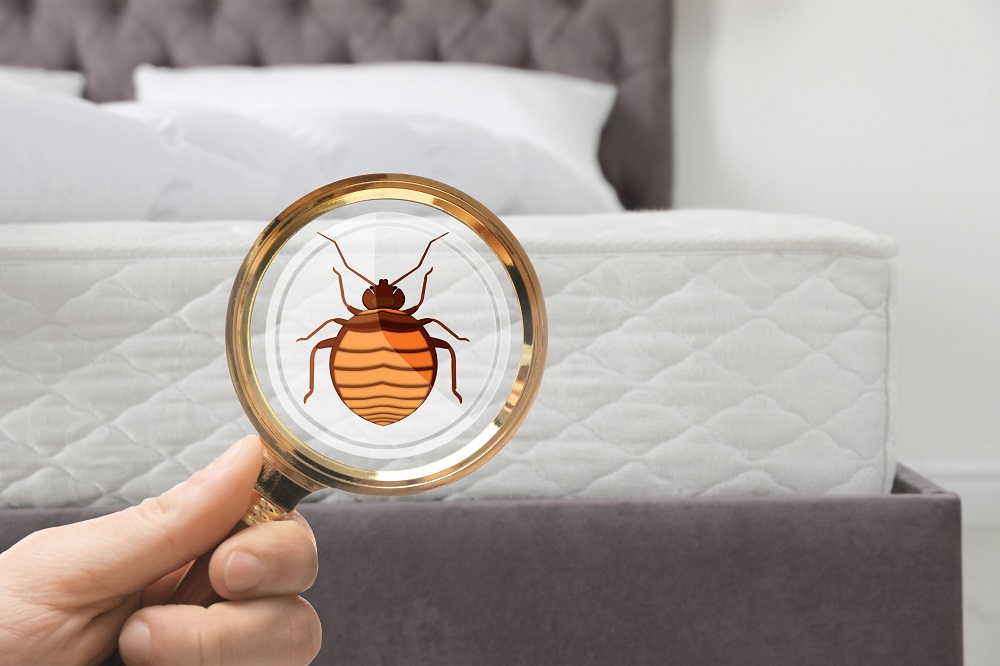The old saying “don’t let the bed bugs bite” takes on a whole new meaning if you have them in your home. Just the thought that tiny bugs might be crawling all over you while you sleep is enough to send a chill down your spine. And no matter where you live, there’s no naturally-safe place to hide from them.
Want to sleep easy? Read on to learn what signs to look for and what you can do to sleep peacefully once again.
What Are Bed Bugs?
Bed bugs get their name from their habit of taking refuge in beds and feeding on humans while they sleep. These little monsters feed only on blood. While humans are their preferred target, they will also feed on other warm-blooded animals. Bed bugs have been hunting human blood for thousands of years and are found in virtually every place people tend to gather.
Bed bugs are great “hitchhikers.” They latch onto suitcases or clothes and can end up wherever these items are taken. This is why bed bugs spread so easily. Their bites are easily confused with other pests, which helps them stay undetected as their population grows.
While their bites can be small, if they swell and become itchy, they are quite noticeable. It can take several days for these bites to appear as red welts. However, bites alone do not indicate an infestation without other bed bug evidence.
Sign #1: You See Them
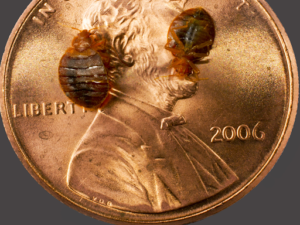 Of course, a visual confirmation is the most obvious sign that you have bed bugs. They could be at home in your bed, but also look around your bed. Check nearby furniture, the headboard, the mattress, and the nightstand.
Of course, a visual confirmation is the most obvious sign that you have bed bugs. They could be at home in your bed, but also look around your bed. Check nearby furniture, the headboard, the mattress, and the nightstand.
Bed bugs are an oval shape, and a mature bed bug is the size of a small seed. Prior to feeding, they are brown and flat. After feeding, bed bugs become swollen, elongated, and more red in color. Despite having vestigial “wing pads,” bed bugs do not have wings and cannot fly. That’s hardly a consolation, as they can withstand temperatures from near freezing up to 122 degrees Fahrenheit, allowing them to survive in harsh climates.
2. Shells and Skins
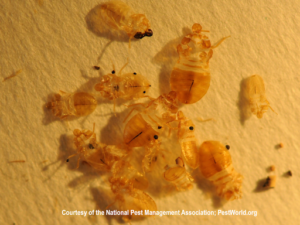 Bed bugs grow as they mature and even every time they eat. They take 5-10 minutes to engorge themselves with blood and then move to a safe place to digest their meal, mate, and lay eggs. They are usually nocturnal. They can even go months between feedings, so just because you don’t see them doesn’t mean they are there.
Bed bugs grow as they mature and even every time they eat. They take 5-10 minutes to engorge themselves with blood and then move to a safe place to digest their meal, mate, and lay eggs. They are usually nocturnal. They can even go months between feedings, so just because you don’t see them doesn’t mean they are there.
As they increase in size, they shed their shells and excess skins. Bed bugs usually molt five times as they mature. If you see evidence of insect exoskeletons or skins, you could have a bed bug infestation. Check all over, under, and around your bed and in carpeting for any signs of bed bug shells.
3. Bed Bug Eggs
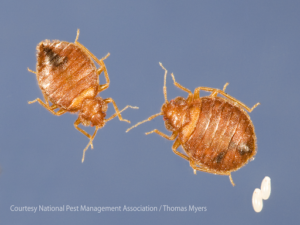 Adult male and female bed bugs with eggs
Adult male and female bed bugs with eggs
As if blood-sucking invincible bugs that eat us in our sleep weren’t bad enough, bed bugs reproduce alarmingly fast. Females lay up to five eggs per day, and it only takes three weeks for these nymphs to reach adulthood.
If a bed bug population goes undetected, these bugs can quickly infest an entire household or building. Once established, an infestation can be extremely difficult to get rid of. The eggs (or egg shells if they’ve already hatched) are pearl or white in color, often appearing in clusters.
4. Bites
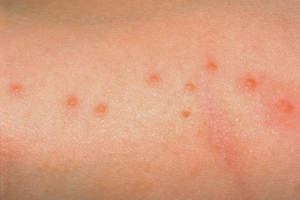 Humans are the preferred host for bed bugs, and they will latch onto skin that is exposed while the host is sleeping. Although the bite is painless at the time of the attack, most people develop an allergic reaction to the saliva that is transmitted during the bite. This is what causes bites to become red, itchy, and swollen.
Humans are the preferred host for bed bugs, and they will latch onto skin that is exposed while the host is sleeping. Although the bite is painless at the time of the attack, most people develop an allergic reaction to the saliva that is transmitted during the bite. This is what causes bites to become red, itchy, and swollen.
Bed bug bites take the form of red welts and tend to be found in a line or in small clusters, usually on the limbs or shoulders.
Not everyone will have a reaction to a bed bug bite. Those over the age of 65 usually don’t have any reaction.Children will often have bug bite welts on their face while adults will not. In fact, it is possible that two people who sleep in the same bed are both bitten by bed bugs and one will break out with sores and the other person will not.
5. Fecal Matter
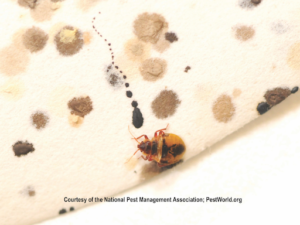 Any seasoned hunter will tell you to follow the droppings of your target. Bed bugs produce dark brown or black liquid waste that can stain your sheets and furniture.
Any seasoned hunter will tell you to follow the droppings of your target. Bed bugs produce dark brown or black liquid waste that can stain your sheets and furniture.
Look carefully at your sheets, mattress, and upholstered furniture. If you notice a lot of small, brown-colored stains, it’s possible you have a bed bug problem.
Say Goodbye to Bed Bugs
Bed bugs are notoriously hard to eliminate by yourself. If bed bugs are bugging you, TriGuard can help. Our certified technicians are expertly trained to inspect and detect bed bugs in your home or business. Contact us for a fast, free bed bug estimate, and we’ll have a plan in place within 24 hours.



